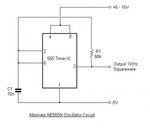sneitzke38
Member level 2
I am using the extech multimeter kit and just got it the other day so the batteries are new
Follow along with the video below to see how to install our site as a web app on your home screen.
Note: This feature may not be available in some browsers.
check you multimeter, frequency meter against a known frequency source - open an electronic watch, crystal driven - there is a crystal oscillator working there and it is 32 kHz. if your reading is much different ( more than 5%, ( I know - 5% error is too big, but this is just to give enough margin ) ), it is the measurement unit not the schematic.
Oh sorry forgot about that it's a Samsung TVyou never mentioned what kind of device you are trying to jam




Thats good news but how do i get the decoupling capacitors in the circuit (where)? I do not know what that term means thanks.